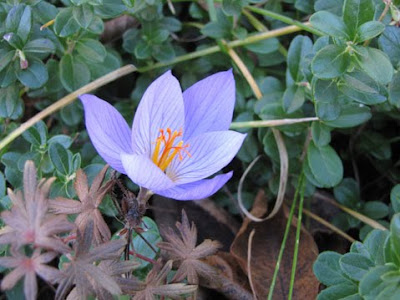The larch tree was in glorious form a few weeks ago. Today its soft, golden needles are gone.
Witch hazel begins blooming in October when most other shrubs and perennials are done or nearly done.
As autumns go, this one is more muted than others. Oh sure, there has been some color but it was shortlived, cutting out long before it should have. Blame it on the sodden, gray, cold October -- the foliage seemed to give up early, calling it quits before the reds, yellows and bronzes were fully developed and dropping quickly into swaths of brown leaf litter. Still, there were a couple of bright spots -- the larch, or tamarack, and the witch hazel. Both are worthy choices in the northern landscape.
Our best representative of the native American larch (Larix laricina) has settled in nicely at the end of the driveway. It's a good companion for the trio of black spruce, also native here. Both species like it boggy and are happy in the low area where they were planted. Larch is a crazy conifer, bearing cones but also shedding its soft needles in fall like a deciduous tree. Because this one is sited next to the spruce, its bright gold contrasts sharply with the green of the spruce. It punctuates the season like a giant exclamation point. It! Is! Autumn! Enjoy!
Witch hazel is another one of the kinda crazy relatives in the plant kingdom. Native witch hazel, Hamamelis virginiana, starts blooming in October when much of the rest of the garden is easing into dormancy. The threadlike petals look like miniature party streamers. You have to look closely, not only are the flowers small, they start blooming when the shrub still has leaves, making them somewhat difficult to see if you're not paying attention. Witch hazel has attractive leaves, attractive bark and attractive form. And it has history, having been used by American Indians for hundreds of years to treat cuts and bruises as well as colds and coughs.
Medicinal plant expert
Steven Foster says the shrub was a favorite "witching stick" of dowsers searching for water in colonial America. It has nothing to do with witches but comes from the old English word for pliable branches "wych". I've never used witch hazel although I have seen it recommended for use as an astringent or to soothe insect bites.
Even in autumns when color runs rampant across the landscape, larch and witch hazel are notable for their contributions. And in a fall like this one they're appreciated even more.










